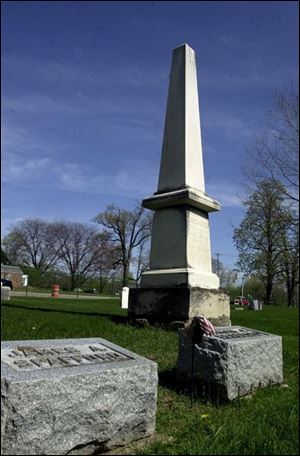
Early settlers to be reburied
4/30/2003
An obelisk at Fort Meigs Union Cemetery in Perrysburg and small stones nearby pay tribute to members of the Spafford family. The remains of at least seven family members are to be reburied there.
Three years after a sewer-line crew accidentally dug them up, the bones of at least seven Perrysburg settlers will be returned to the earth May 10 in a nearby cemetery.
“The Spafford bones,” mortal remains of seven early 19th-century Caucasians, will be interred in a special ceremony at the Perrysburg Union Cemetery, part of a Spafford family reunion and a citywide celebration of Ohio's bicentennial.
“It's going to be a beautiful ceremony, from what I've been told,” said William Spafford of Maumee. “I'm very happy with how it's all turning out.”
The saga began in 2001, when construction began on the new Fort Meigs State Memorial Park Visitors' Center. A backhoe dug into Fort Meigs Street, a city-owned lane separating the new museum from an adjacent private lot.
Up came bones, coffins, and hardware - it was an unmarked cemetery for the Spaffords, one of the city's founding families. Fort Meigs historians said later they knew a burial plot was somewhere in the vicinity, but preliminary soundings had not indicated anything in that spot.
Fort officials phoned Perrysburg city fathers, and all agreed to a quiet excavation. Dozens of bones were taken “for analysis” to the Columbus headquarters of the Ohio Historical Society, which runs the Fort Meigs facility.
They subsequently were sent to Ohio State University, where an anthropology class identified them as remains of at least seven people, one an almost-complete child, according to Professor Paul Sciulli. Further identification would have required DNA testing, a costly, time-consuming procedure.
Meantime, descendents of the Perrysburg pioneers learned of the hush-hush exhumation, and demanded the bones be properly reburied.
The boxes of bones were subsequently sent to Perrysburg, and kept in an undisclosed location. In recent months, city Administrator Jim Bagdonas tracked down 12 Spafford relations and polled them on what should be done with the remains.
The result is the rite planned for May 10; the city of Perrysburg will pick up the tab. Mr. Bagdonas said he doesn't know what the total cost will be.
Funeral Director Keith Custer is in charge of the 10 a.m. ceremony at a gravesite in the oldest section of the cemetery, near where other, later Spaffords are buried, Mr. Bagdonas said.
A coffin containing the bones will be lowered to the tolling of the “Spafford bell;” seven doves will be released.
The bell tolled for many years from the Exchange Hotel, a Front Street institution built in 1823 by Samuel Spafford that hosted much of Perrysburg's early history, including visits by Presidents William Henry Harrison and James K. Polk, General Winfield Scott, and Daniel Webster.
A list of burials at the unearthed graveyard includes Samuel Spafford - some of the bones to be reburied could have been his.
After the ceremony, descendents from 14 Spafford families now scattered from New York to California will tour Fort Meigs, hear speeches, and witness the dedication of a plaque at the fort that honors the Spaffords' contributions to local history.
“I feel grateful. The city of Perrysburg rescued our ancestors from underneath the road,” William Spafford said. “They took good care of them, they've been responsible, and they're paying for all this.”
“We're pleased,” said Tonia Spafford Cannon, a Colorado resident who said the “bones controversy” has revitalized Spafford ties across the nation. “This will hopefully bring a final sense of closure to our family.”